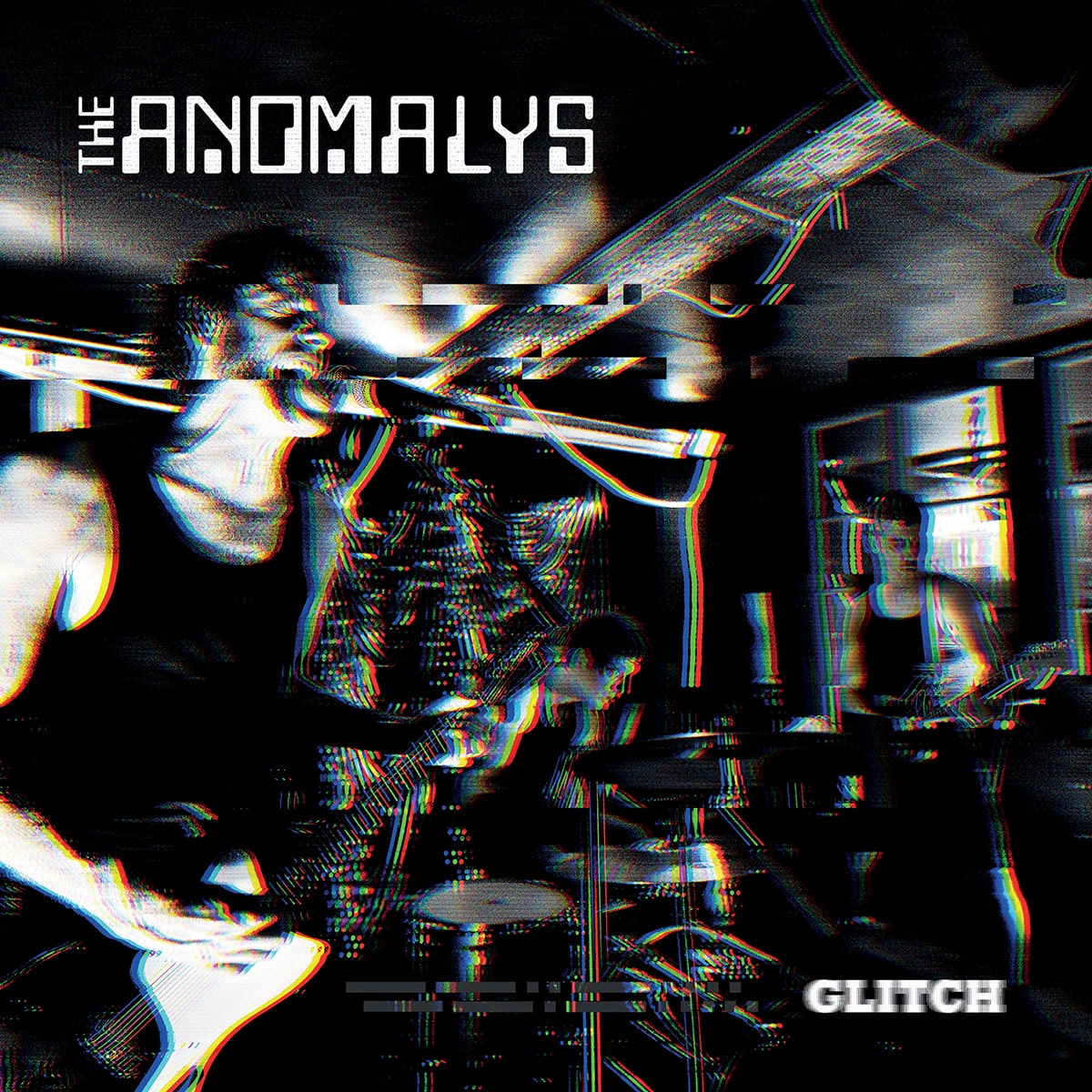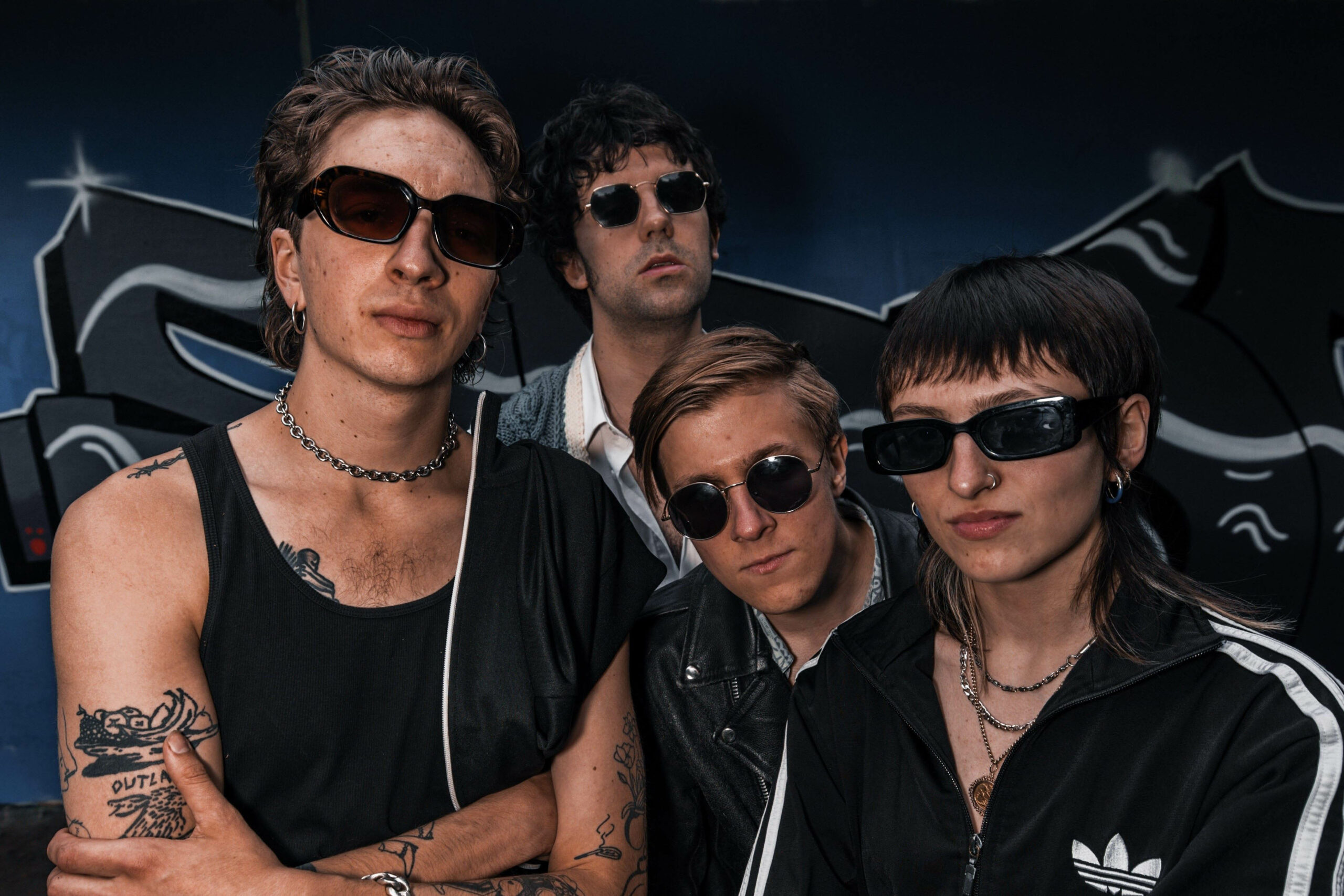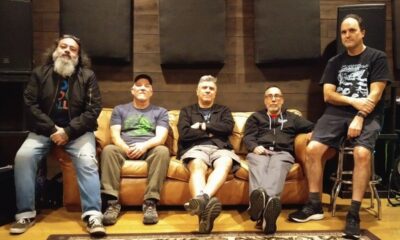Hardcore/Punk
An Interview with Bone on Seventeen Years of The Anomalys
The Anomalys’ new album, ‘Glitch,’ is out now via Slovenly Recordings. We connect with Bone about the music and then some.

A reasonable claim Amsterdam can hold for itself is that its cultural notoriety stems from its unprecedented art history with names like Vermeer, Van Gogh, and Rembrandt holding a degree of responsibility for the millions of tourists descending upon their canal-laden streets. The city’s quaint, Dutch Baroque architecture, Old World folklore mystique, and reputation for being the birthplace of many notable figures throughout the arts, sports, literature, and politics are just three of many reasons for Amsterdam’s high number of annual draws. There’s a lot of high-brow reasons to visit this place but donnish culture aside, Amsterdam is an epicenter in European rock and roll culture and is the home to some well-regarded groups throughout the years. Some, have managed to attract the American listener.
AFN radio broadcasts throughout post-WII Indonesia hold a degree of responsibility for one of the first waves of Eurorock in the 1950s. Repatriating Indonesians & Moluccans brought their admiration for early rock n’ roll, tropical heritage, and skilled guitar work to the Dutch entertainment industry as a means to a living. Indorock had arrived and many of these groups like The Tielman Brothers found great success throughout The Netherlands and Germany with their acrobatic live gigs. By the mid-1960s, Indorock gave way to The Hague’s Nederbeat movement as a counterpart to the American garage rock sound of the time. Amsterdam’s own The Outsiders experienced brief commercial success in their home country opening for The Rolling Stones but unfortunately wouldn’t attract much attention outside The Netherlands until years after their breakup in 1969.
In the 1970s, the tragedy of Herman Brood’s self-destructive habits was equally as notorious as his commercial success at home as a rock n roll singer and later as a painter. Brood’s 2001 suicide in Amsterdam was a national tragedy with the funeral services at the 1,750 capacity Paradiso attracting a large spectator crowd outside the former church-turned-venue paying their last respects to what his critics called “The greatest and only Dutch rock n’ roll star.” Demonstrations against President Reagan’s nuclear arms deployment within the country, violent citywide clashes between mobile police units and squatters, and learning about punk rock from abroad fueled the dissonance, speed, and aggression of a small but powerful sounding punk movement taking hold within Amsterdam in the early 1980s.
The hardcore punk outfit, B.G.K and anarcho-experimentalists, The Ex would release some of the most brutal and raw-sounding music the country’s ever exported onto the Touch & Go and Alternative Tentacles labels. Up until the late 1990s, the muddy punk sound of Claw Boys Claw brought them critical acclaim and some of the largest stages in Europe with Roskilde and Pinkpop festival appearances. However, lack of commercial appeal and failure to attract considerable American audience interest resulted in Polydor Records dropping the group and the band’s return to the indie circuit.
In the new millenium, the garage punk outfit The Anomalys have for the most part flown under the radar in their home city throughout their seventeen-year activity. “There’s a very tiny subculture here in the Netherlands and outside of that small group, we never got much attention,” explains Bone, the band’s founder and one of Amsterdam’s long-time resident and recognizable underground rock n’ roll names. The tall, lanky blonde Dutchman has been the primary driver for The Anomalys since first forming the band in 2005 and has a long resume entrenched in the underground circuit.
On the surface, Bone’s occupations make him sound like he’s nothing short of a party machine as a musician, DJ, producer, promotor. He’s a rock n’ roll lifer, no doubt, but he takes his work as seriously as does a surgeon preparing for a heart transplant. His current CV doesn’t leave him much free time and looks something like this: member of four active bands, DJ residency for seven different rock clubs around the city, promoter and event organizer, radio DJ for three different independent stations around Amsterdam, and a locally an in-demand graphic designer specializing in typography and comic illustration. Different hats in the game. “You need to bet on multiple horses if you’re trying to make a living doing any type of endeavor related to independent music, it’s impossible to rely on one means,” Bone states.
He’s done well for himself in the independent music world partnering with renowned underground rock n’ roll labels Slovenly Recordings and Voodoo Rhythm Records on a slew of releases. His partnership with Slovenly Recordings dates back to 2005 when they scooped up the band in their infantile stage and are now on the heels of releasing The Anomalys’ new album, Glitch. With some free time to spare, Bone spoke to V13 Media about the happenings in his world.
Bone, thanks for taking the time to talk to us. For those over here who don’t know you and your work, can you tell us about your backstory? What was your early life like growing up within the Dutch punk rock world throughout the early 1990s and was your family supportive of your music endeavors?
Bone: “Thanks for having me. I guess the pivotal moment concerning garage rock in my life in the ’90s was hearing The Gories on the radio. I remember going to Amsterdam’s most alternative record store and buying their first record. It was on my turntable for months. I guess the second trigger to go this path was seeing The Mummies play live at the Patronaat in Haarlem. I thought it was the best thing ever and what I wanted to do. Since I was twelve, I had already played drums and played in all kinds of high school bands. But this was something completely different. I started putting up ads in search of like-minded spirits to no results.
“Eventually, I worked in our local garage punk rock and roll bar De Diepte. It was there that I met another barkeeper who was as big a Gories fan like me, so we decided to start a band together. Unfortunately, she also played drums, as I came to find out. So there was the moment I decided to buy a guitar and start to be a guitarist/singer. My first garage-punk duo, The Bones, was a fact and consisted of Claudia Hek on drums and me on guitar and vocals. I always found it very strange to see The White Stripes pop up as we played red and white drums and a red and white guitar. We even had red and white clothes and red hair!
“My family was a pretty musical one with my father playing piano and my sister playing piano and eventually harp. And me playing drums. So you can imagine the interesting combination of instruments for Christmas evenings. Anyway, by the ’90s, I was squatting in Amsterdam. It was an interesting time to be there. Transitional is going from the ’80s punk squat scene into a more open-minded creative era. There were tons of venues all over the city, and of course, every first thing to be built in the cellar of every squat I lived in was a practice room. From very early on, I started booking bands in venues and squats around town, for I always produced posters and flyers. And it’s what got me into Dj-ing to provide the right atmosphere around the gigs.”

Artwork for the album ‘Glitch’ by The Anomalys
You’ve been playing in bands your whole life since your squatter days but The Anomalys are your longest-tenured project. Can you talk about where you were in your life when you first began this band and out of all the groups you’ve played in throughout your life, how does writing for this band differ from the others (i.e. Los Looches, CarCrash, The Amoks, The Sex Organs, The Pedro Delgados)?
“When we started The Anomalys, it was again a duo. Since all our bands were dead at that moment. The first drummer Menno came from another line of bands important to the Amsterdam garage scene. Dexter, Surf Hell, Franco Formica. I was a bit frustrated with all the quitters in my bands and decided to give it my last shot and go all the way with it. Menno was already friends with Pete [Menchetti], so that’s how we ended up on Slovenly Recordings. This band differs from my other bands because it’s a more personal band. Less funny and dumb but darker. The Anomalys started as a therapeutic band. I find it more balanced these days, but our early work was very aggressive and destructive.”
Let’s talk about Glitch. This is the first album from The Anomalys in twelve years and the first full length to feature the new lineup of Looch Vibrato and Remy Pablo. Looch’s known from his project The Magnetix but where did you find Remy from and how far back is your history with these guys? How did you know they’d be a good fit to replace Potlood and Memme?
“My history with Looch goes back to when I was the driver/road manager for the first European tour for The Black Lips in 2003. I was already familiar with the music of The Magnetix, but that was the first time I met them as The Magnetix and The Black Lips played two shows together in Spain. I did not know Remy, but Fred [Brissaud], the saxophone player of King Khan and His Shrines, is playing in a band with Remy called Weird Omen and knew that we were looking for a new drummer. At this time, Remy was living in Brussels and already a huge fan of The Anomalys, who he had seen playing in France before.
“So, basically, after one rehearsal, he almost kicked our ass with the songs he was in. Immediately we had a remarkable musical click. Remy understands the percussiveness and breakbeat/breakneck style of The Anomalys very well. A year later, though, my guitar player decided to call it a day after ten years and break his foot when jumping off a stage in Spain. So since Remy had moved back to France, it made sense to call my friend Looch for the job as I wanted someone in the band my age more or less, or at least someone I could trust for being a lifer in this music scene.”
Given you’re in the Lowlands while the other two live just south of you in France, how were you all able to get together to make this recording happen with all the COVID protocols in place? Were you all able to get in a room together and go at the songs live or were any of the songs from Glitch recorded remotely?
“We luckily recorded the album right before the whole COVID pandemic went down. We spent three days in Toulouse with Lo Spider at his notorious Swampland Studios. Everything on Glitch is recorded live. I wouldn’t have it any other way. I think it is vital for a record’s sound and feel. We did spend quite a lot of time on the mix, though. It was mixed, mastered, remixed, and remastered. I am pleased about that, though, because it now sounds like it should. Of course, then came all the delays with the pressing plants. What a nightmare…”
What do you guys have coming up this year to help push the new album? Are touring plans in limbo or being discussed? With all the touring you’ve done over the years, where would you like to play next or play before you decide to hang up The Anomalys altogether?
“The album release party will be on March 20th with King Khan Unlimited. We have a bunch of festivals coming up in the summertime in France. We just returned from a Spanish tour, but unfortunately, the record was not there yet, so we hope to return soon. Just before the pandemic, we were planning a tour in Japan, so I hope one day to do that. I would also like to return to South America again along with Mexico and Australia too. And of course, we hope to play We’re Loud Fest in Africa. Since this is the only continent, we never played. Let’s see how far we get with all the new catastrophes on this planet. As far as I’m concerned, I will never hang up on The Anomalys. However, I wish to become a respectable older man, if you know what I mean hehe.”
You’re also an illustrator who’s done a grip of posters and art direction for venues around Amsterdam and bands in the punk n’ roll genre? How long have you been doing this and who exactly began your interest in graphics work? Were you trained formally or all just learning on your own? What piece have you done that you’re proudest about and what are you working on right now in this world?
“Since I can remember, I have been drawing. I’ve spent most of my time drawing comics and such in school instead of paying attention. Creativity was always very much stimulated in my family. My father was a very talented drawer/painter, so that’s where that came from, I guess. Then in the ’80s, I became involved with the Hip Hop graffiti culture, where my love for lettering and typography originated. I spent three months in art school, but I found that a waste of time as I was starting squatting and was way more interested in psychedelics.
“I hope to start this year with my book, an overview of 35 years of garage punk in Amsterdam, for which I’ve drawn hundreds of posters and fliers. Also, there are plans in the making for a book about a garage bar we had here called De Diepte, which was pretty much our Purple Onion in the ’90s and early 2000s. One piece I’m particularly proud of is a record sleeve for The Skidmarks, an Amsterdam-based garage band from the ’90s. I did all the lettering by hand, and it took me about 13 hours to complete. But yeah, I never use fonts; every poster I do is hand-lettered.
Give me five bands you highly recommend our readers check out and a two-sentence max reason why we should give them a listen.
“The Gories – Houserockin’ – First mind-blowing LP that changed my brain about music and is the reason I’m still doing this.
Bassholes – Haunted Hill! – Second record of one of the most underrated garage bands. Big influence on the early Anomalys. I love every record Don Howland has something to do with.
The Cramps – Gravest Hits – All-time classic. nuff said.
The Outsiders – Outsiders – My favorite Dutch ’60s garage/beat combo.
Ivy Green – Ivy Green – My favorite Dutch ’70s punk band.
-

 Music6 days ago
Music6 days agoTake That (w/ Olly Murs) Kick Off Four-Night Leeds Stint with Hit-Laden Spectacular [Photos]
-

 Alternative/Rock2 hours ago
Alternative/Rock2 hours agoThe V13 Fix #011 w/ Microwave, Full Of Hell, Cold Years and more
-

 Alternative/Rock1 week ago
Alternative/Rock1 week agoThe V13 Fix #010 w/ High on Fire, NOFX, My Dying Bride and more
-

 Alternative/Rock2 weeks ago
Alternative/Rock2 weeks agoA Rejuvenated Dream State are ‘Still Dreaming’ as They Bounce Into Manchester YES [Photos]
-

 Features6 days ago
Features6 days agoTour Diary: Gen & The Degenerates Party Their Way Across America
-

 Culture1 week ago
Culture1 week agoDan Carter & George Miller Chat Foodinati Live, Heavy Metal Charities and Pre-Gig Meals
-

 Music1 week ago
Music1 week agoReclusive Producer Stumbleine Premieres Beat-Driven New Single “Cinderhaze”
-

 Indie2 hours ago
Indie2 hours agoDeadset Premiere Music Video for Addiction-Inspired “Heavy Eyes” Single










